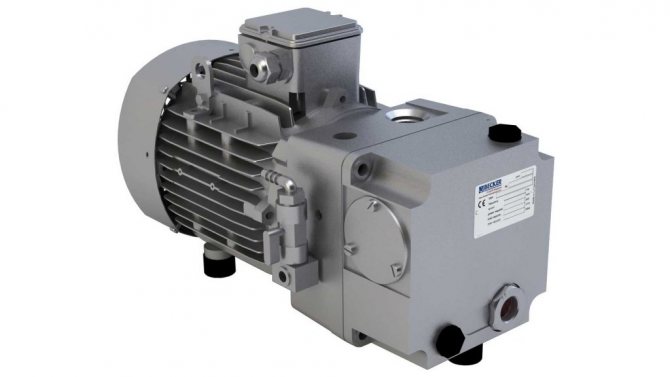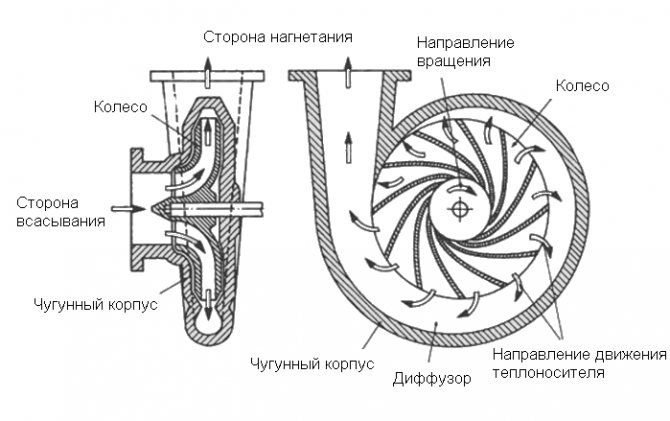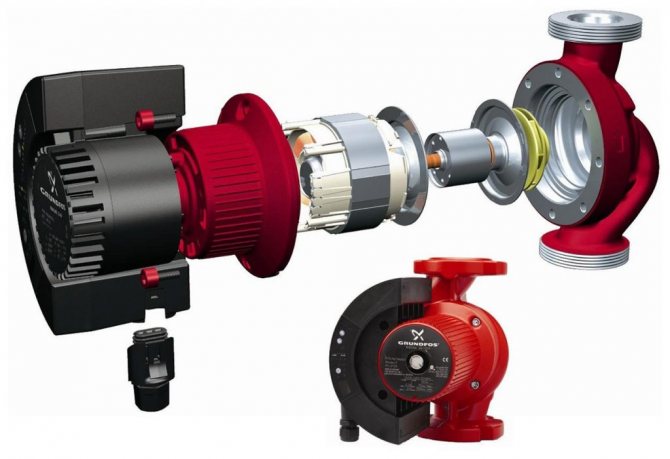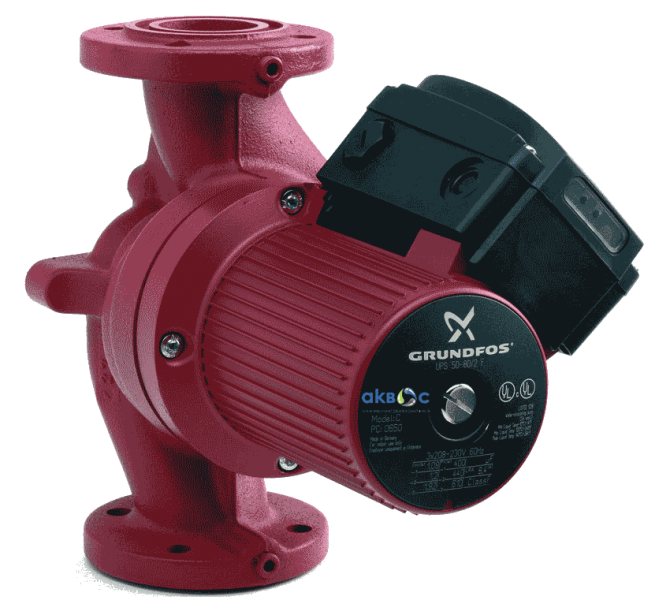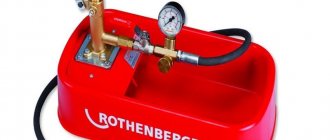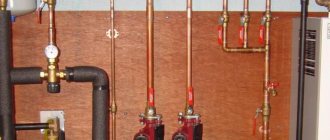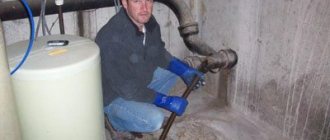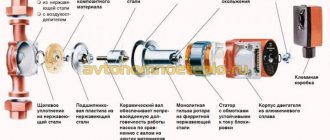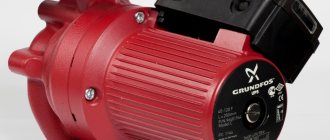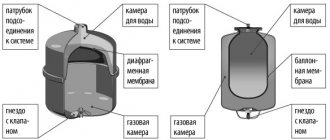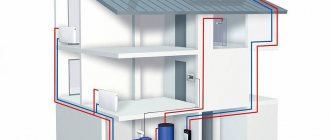devices with a wet dry rotor, advantages and disadvantages
For pumping liquid, many use a rotary circulation pump.
A rotary pump is a mechanism that is used to pump various liquid masses in large volumes. On the modern market, you can find a variety of types of these devices, which differ in the principle of operation, design and price. Each buyer can choose for himself exactly the device that he needs.
The content of the article
Working principle and dignity
The principle by which rotary pumping equipment works is to pump liquid from the inner chamber of the mechanism by pushing it out by the rotor. This is due to a decrease in the working space of the chamber, where the pumped mass first enters. Moving parts of the rotor changes the volume of the chamber and thus carries out the pumping.
The main advantages of a rotary pump are uniform fluid supply and high speed of frequency of movements.
The main element of the rotor is a hollow disc, which rotates to adjust the pumped mass from the suction to the outlet. If it is necessary to pump liquids containing solids, then, as a rule, the unit is equipped with one disc. It rotates rather slowly, but thereby reduces the likelihood of breakdowns and increases the life of the pump. However, there are often devices equipped with several disks.
Advantages:
- Quite uniform fluid supply;
- The presence of a reverse stroke, which makes it possible to use the device as a hydraulic motor apparatus;
- Highest possible efficiency due to the absence of valves in the design;
- High speed of frequency of movements.
As for the disadvantages, they lie in the rather high cost of such equipment and sensitivity to the pumped liquid - it should not contain abrasive particles and too aggressive chemicals that can violate the integrity of the device.
If you choose by brands, then Grundfos pumps ("Grundfos") are very popular, which are distinguished by their quality and high performance, due to which they are in demand all over the world.
Varieties of products
When deciding which pump is better to choose, you should understand the types of such devices and the principles of their operation.
Rotary lobe pumps are either linear or rotary
A rotary pump is:
- Translational - it has more compact dimensions and gearing inside. There are slide and piston. The former are rather cumbersome, but at the same time they can pump fluids from great depths. The latter are also divided into two types: radial and axial. The latter run mainly in parallel and are equipped with swash plates and discs. Torsion from the engine is transmitted using a special connecting rod located inside the piston. The former move only in the radial direction.
- Rotational - in this case, the device is "powered" by electricity. More precisely, electricity powers the electric motor, which transfers power to the rotor itself. The shaft begins to rotate and, in contact with the teeth of the disc, sets it in motion.
Rotary pumps are more common among consumers and are divided into devices with wet and dry rotor. "Wet" people basically work with a working fluid inside them. And the "dry" ones can be launched without having anything inside them.
Glandless circulation pump
A circulating pump has something in common with drainage pumps. Regardless of the rotor type, the housing is often made of brass, stainless steel, cast iron or bronze. The rotor is made of either ceramic or stainless steel. The impeller with blades is located on the rotor shaft itself.
The principle of operation is to create a centrifugal force inside the device. Rotating, the rotor makes the blades move quickly, lowering the pressure in the working chamber. This increases the flow of liquid into the container. Then the pumped water increases the pressure in the tank and, due to this differential, is pushed out.
As for the device with a wet rotor, its peculiarity lies in the fact that the impeller blades are in the pumped liquid. At the same time, all electrical equipment of the device is reliably sealed and separated from direct contact with water.
A circulating pump with a wet rotor is in demand today.
Advantages of a wet rotary pump:
- Due to its presence in a wet environment, the pump does not overheat;
- The liquid absorbs all vibration sounds of the device, which makes it virtually silent;
- The unit is lightweight and compact;
- It can work for a long time without stopping;
- Easy to install, maintain and repair.
The disadvantages of such devices include only low efficiency, so such equipment is rarely used on long pipelines where good performance is needed.
Dry rotor unit and its features
The peculiarity of this type of pump is that it works without contact with the pumped liquid. The main advantage of such a pump is that such equipment has a very high efficiency, which can reach 80%.
But despite this, such devices have disadvantages:
- Quite a high level of noise emitted during operation;
- Demanding in the pumped medium - there should not be any debris or air bubbles.
In this case, "dry" rotor systems are divided into vertical and horizontal (console). In the first, the engine is located vertically, and the pipes are on the same axis. In the second, the motor is in a horizontal position, and the pipes are perpendicular to each other.
Thus, rotary circulation pumps are excellent for pumping various liquids. Depending on what mass will be distilled, you should choose a pump with a dry or wet rotor.
Circulation pump device for heating
The circulating pump consists of a stainless steel casing in which the electrical unit is fixed. The design of the latter includes a rotor located inside the stator winding.
The circulating pump device includes an impeller attached to the rotor shaft. When electricity is supplied, the impeller rotates, which leads to the suction of the coolant from one side of the pump and pushing it out from the other side. The head formed by the unit suppresses the hydraulic resistance of the heating system components, which leads to an increase in the speed of movement of the coolant.
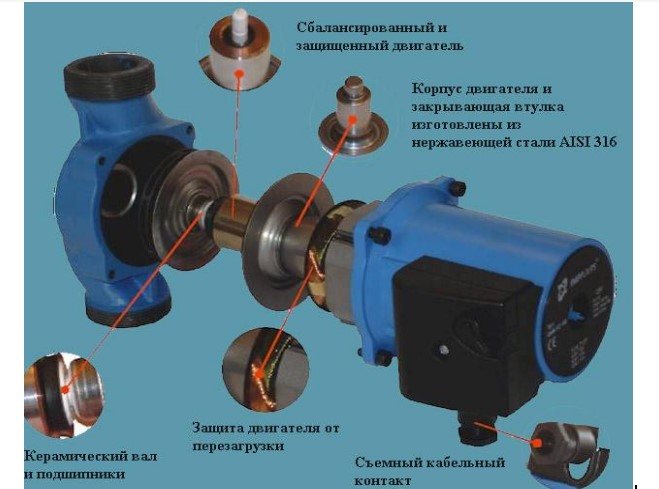
principle of operation. Variable speed pumps
Glandless pump design
IN wet rotor pumps
the rotor of a special electric motor is immersed in the pumped medium. A spacer sleeve integrated into the motor housing protects the stator coil. This bushing is made of non-magnetic high alloy steel. The shaft is made of stainless steel and rotates in graphite bearings. The shaft sleeve is stationary. The medium pumped through the system under pressure simultaneously cools it and reduces friction in the bearings.
Installing a glandless pump in a direct or return line ensures fast and intensive movement of water. As a result, it becomes possible to use pipelines with a smaller cross-section.This leads to lower costs for the heating system. This also means that there will now be significantly less water in the lines of the system. The heating system can react more quickly to temperature fluctuations and is easier to adjust.
Features of the
A distinctive feature of the impeller of a centrifugal pump is the radial movement of water. The shaft driving the impeller in rotation is made of stainless steel; shaft bearings are made of sintered carbon or ceramic material. The rotor of the motor, mounted on the shaft, rotates in the water. Water lubricates the bearings and cools the motor.
The energized stator of the motor is surrounded by a separating sleeve. It is made of non-magnetic stainless steel or carbon fiber and has a wall thickness of 0.1 to 0.3 mm.
For special applications such as water systems, fixed speed pump motors are used.
If a glandless pump is used, for example, in a heating circuit, and therefore is intended to supply heat energy to a radiator, it must adapt to the changing thermal load of the building. Thermostatic radiator valves installed in front of the heating surfaces determine the flow rate of the pump.
Pump heating system
In order to reduce energy consumption, it is necessary that the motors of pumps with a wet rotor constantly change the speed. The speed can be changed manually using switches. It is also possible to organize an automation system by installing switching equipment and control devices, which will be triggered depending on time, pressure difference or temperature.
Since 1988, there have been designs with built-in electronic devices that provide stepless speed control.
First fully electronic glandless pump with integrated infinitely variable speed control
Glandless pumps, depending on the size and the required output power of the pump, operate on a 1 ~ 230 V ~ or 3 ~ 400 V three-phase mains supply.
Glandless pumps are quiet and, due to their design, have no shaft seals.
The design of the current generation of glandless rotor pumps is based on a modular principle. Depending on the size and required output of the pump, the modules are assembled in different configurations. Thus, any repair that may be required can be done with less labor by simply replacing the part with a spare.
An important quality of this type of pump is their ability to independently evacuate air during commissioning.
Installation methods
Glandless pumps are supplied with threaded connections up to R 1¼. Larger pumps have flange connections. These pumps can be installed in the pipeline horizontally or vertically without building a foundation.
As mentioned earlier, the bearings of such a pump are lubricated with a working fluid. It also serves as a coolant for the electric motor. Therefore, liquid must be constantly circulating through the separating bowl.
When it is necessary to heat large rooms with a total area of several hundred square meters, the pressure in the autonomous heating system with natural circulation (about 0.6 MPa) created by the heating heater is usually insufficient.
To solve this problem, you can go in two ways: 1. Build a closed system using large-caliber pipes, which are not cheap. 2. Turn on the circulation pump in the system.
The second option is more economically feasible.Thanks to the improvement in the circulation of the coolant in the system, the heating efficiency increases significantly.
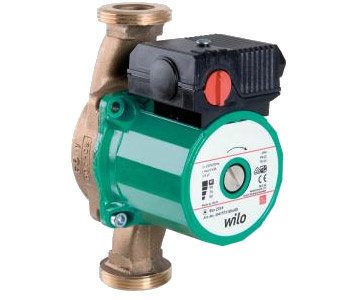

Circulation heating pumps are divided into two types: 1.With wet rotor.
They are used in the heating system of private households, where the length of the pipelines is not so great. The rotor of the pump, equipped with an impeller, rotating inside the housing, accelerates the movement of the coolant. The fluid inside which the rotor rotates cools and lubricates the mechanism. When installing a "wet" pump, pay attention to the horizontalness of the shaft, then there will always be water inside the casing. Advantages of pumps with a wet rotor: - practically silent; - stepless switching of the rotor speed; - reliability in operation; - long service life; - no need for maintenance; - ease of repair and adjustment of the pump;
- relative cheapness. Disadvantages: - low efficiency (no more than 50%)


2.With dry rotor.
They are used in long-distance heating systems. O-rings are installed between the electric motor and the working part of the rotor, the service life of which is 3 years. There is no contact between the rotor and the coolant. Advantages: - high efficiency - about 80%; Disadvantages: - high noise level, and therefore they are installed in a separate room equipped with sound insulation; - the need to control the absence of suspended particles in the coolant and dust in the air surrounding the engine in order to avoid damage to the surfaces of the sealing rings, which can cause their damage and leakage.
When choosing the type and model of a circulation pump for a heating system, one should also take into account their performance, operating conditions, features of the coolant (its viscosity and density), the manufacturer's recommendations and requirements for the installation and quality characteristics of the pumped liquid.
Today, you rarely find a home heating system built according to the classical gravitational scheme. A circulation pump for heating is used almost everywhere. This device is useful and functional, but reduces the overall requirements for the accuracy of the pipeline network design. At the same time, without a forced circulation source, it is impossible to operate such technologically advanced heating systems in a private house or apartment as a warm floor.
Circulation pump device - implementation of the standard scheme centrifugal machine
... The main structural units include:
- pump housing;
- a rotor transmitting rotation from the engine shaft to the turbine unit;
- a turbine impeller with inclined blades, which is also called an impeller;
- means of sealing, isolation from water or heat carrier;
- main electrical circuit that switches operating modes and monitors engine parameters.
Circulation pumps can have different body shapes and the location of the branch and inlet pipes. This is done so that the device can be easily installed, maintained in the operating conditions for which it was designed. In particular, the selection of the pump can be made by the type of connection: with a flange, threaded connection, nut.
The circulating pump has small size
... It is often built directly into the inner cavity of the housing of household gas heating boilers. Safety devices can be assembled with the pump. The small dimensions of the blower are easy to understand when considering the purpose of the circulation pumps. They do not require record-breaking fluid delivery. In fact, they literally move the water horizontally.
The task of circulation pumps is to overcome the hydraulic resistance of pipelines.
If a collector group for a warm floor is considered, the blower is busy creating a very small volume flow as such, since there are no significant gravitational forces in this type of heating circuit.
The principle of operation of the circulation pump
several
Installation principles for units with any rotor
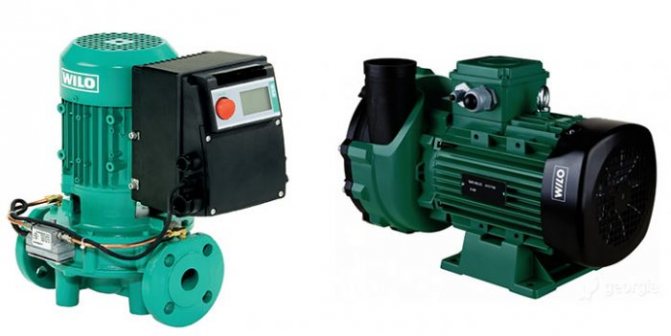

In order for the operation of the circulation equipment to be of high quality, it is better to invite specialists to install it. But if there is a doing to install the pump yourself, then adhere to these rules:
- The installation of the unit is carried out at the boiler from the reverse side. That is, where the water that has passed through the entire closed loop of the system comes back again. But this rule applies to premises whose area does not exceed 150-200 m2.
- It is important to observe the location of the arrow on the pump housing when installing it. The arrow should point towards the flow of warm water through the system.
- All flanged and threaded joints must be sealed with sealant to avoid possible leaks.
- If you are dealing with a reverse circulation heating system, then it will not be superfluous to install a bypass - a piece of pipe that, in case of repair of the unit, will be able to close the heating circuit after removing the pump.
what it is and how it works. Rotary pumps.
In this article, we tried to collect all the possible principles of pump operation. Often, in a wide variety of brands and types of pumps, it is quite difficult to understand without knowing how this or that unit works. We tried to make it clear, as it is better to see once than hear a hundred times. In most descriptions of the operation of pumps on the Internet, there are only sections of the flow path (at best, the schemes of operation in phases). This does not always help to understand exactly how the pump functions. Moreover, not everyone has an engineering education. We hope that this section of our website will not only help you in choosing the right equipment, but also broaden your horizons.
For a long time, the task was to lift and transport water. The earliest devices of this type were water-lifting wheels. It is believed that they were invented by the Egyptians. The water-lifting machine was a wheel, around the circumference of which jugs were attached. The lower edge of the wheel was lowered into the water. When the wheel rotated around the axis, the jugs scooped up water from the reservoir, and then at the top of the wheel, the water poured out of the jugs into a special receiving tray. use human or animal muscular strength to rotate the device.
Archimedes (287–212 BC), the great scientist of antiquity, invented a screw water-lifting device, later named after him. This device lifted the water with the help of a screw rotating inside the pipe, but some of the water always flowed back, since in those days effective seals were unknown. As a result, the relationship between screw tilt and feed was derived. When working, it was possible to choose between a large volume of raised water or a higher lifting height. The more the screw is tilted, the greater the feed height with a decrease in capacity.
The first piston pump for extinguishing fires, invented by the ancient Greek mechanic Ctesibius, was described as early as the 1st century BC. e. These pumps, by right, can be considered the very first pumps. Until the beginning of the 18th century, pumps of this type were rarely used, because made of wood, they often broke. These pumps were developed after they began to be made of metal. With the onset of the industrial revolution and the advent of steam engines, piston pumps began to be used to pump water from mines and mines. Currently, the piston
Differences between pumps with "wet" and "dry" rotor
07.01.2014
It was believed by many that for domestic use it is necessary to take circulation pumps with a wet rotor.Dry rotary circulation pumps were used for industrial use.
It was believed that dry rotor pumps are oversized and noisy. However, large manufacturers began to produce more and more household models of circulation pumps with a dry rotor.
The industry uses dry rotor circulation pumps.
In the domestic version, circulation pumps with a wet and dry rotor are used. For industrial needs, pumps with a wet rotor are not used, since they can be produced with a power of up to 3 kW and they are not widely used.
Advantages of circulation pumps with a dry rotor of industrial design: the quality of the coolant is not important for them, they have good maintainability. The downside of these pumps is that they are large, make a lot of noise, so they are installed in separate rooms, consume a lot of electricity.
As for the domestic version of the pump with a dry rotor, its advantages:
has a higher efficiency;
the purity of the coolant is not important for him;
has good maintainability, and spare parts are cheaper than pumps with a wet rotor;
in size, it almost does not differ from the wet-rotor analogue.
The downside is a lot of noise during operation and the need for regular replacement of the mechanical seal.
The disadvantages of circulation pumps with a dry rotor are the advantages for a pump with a wet rotor: noiselessness, no mechanical seal. The disadvantage is that the quality of the coolant is of great importance during operation. The worse the quality of the pumped liquid, the faster the pump can fail.
Considering all the pluses and minuses of the considered pumps, we can draw appropriate conclusions. If the quality of the coolant is not important to you, then it is better to choose a pump with a wet rotor, but it is not known what will happen to the rest of the heating system.
If you want everything to work smoothly, it is better to use a motor with a dry rotor, but you need to take care of the quality of the coolant.
As for the noise, everyone decides for himself, because the pump does not come into sight so often. The efficiency is not so important, since the difference in percentage is small, but the absence of the need to replace the mechanical seal is a big plus.
However, maintenance should be carried out regularly together with an inspection of the entire heating system by a specialist.
Pump selection rules: "dry" or "wet" rotor
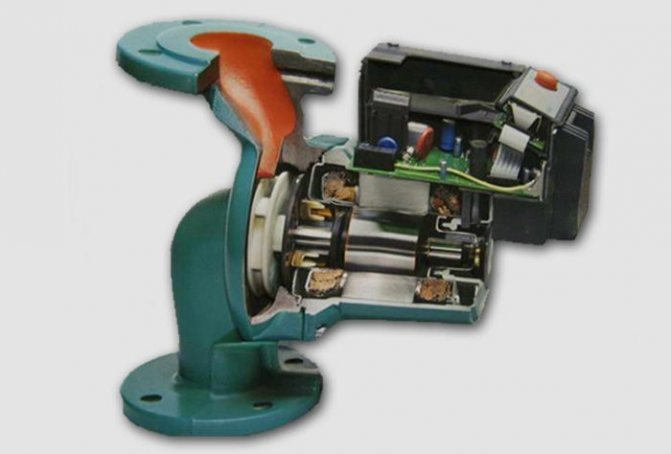

In order for the heating system to work as efficiently as possible, it is necessary to choose the right pump in accordance with the parameters of the house and the characteristics of the heating system. Only in this case, and subject to the correct installation of the mechanism in compliance with the principles of its operation, the heat in the house will be of high quality and lasting.
The principle of operation of the borehole screw pump
So, when choosing a pump, consider the following points:
- The total area of the house and the length of the closed circuit of the heating system;
- The number of radiators for the entire section of the heating system;
- The presence of warm floor systems, etc .;
- Quality and density of plastic window bags;
- Insulation of walls, ceilings or roofs in the house.
Important: calculations of the required amount of heat should be carried out only by competent heating technicians, who will take into account all the important nuances and recommend a pump with pressure characteristics rated for your room.
It is important to take into account that if you choose a pump for a heating system that already exists, but requires improvement, then it is better to buy an adjustable unit. This device perfectly adjusts to the operating parameters of a given circuit.
what it is and how it works. Positive displacement rotary pumps.
A rotary pump is a positive displacement pump with rotary or rotary and reciprocating movement of the working bodies, regardless of the nature of the movement of the pump driving link.Thus, the obligatory movement is rotational.
According to the classification, the main representatives of this group of pumps are gear, vane, radial piston and axial piston.
It is important that the company builds industrial equipment and installations, that the pump is durable, so that its parts do not wear out frequently and are easy to maintain. A manufacturer of paints, varnishes and specialty chemicals was looking for an efficient pump for pumping parquet and tile adhesives. Until now, piston diaphragm pumps have been used for this purpose. However, the efficiency of these pumps decreases as the viscosity increases. Moreover, their use is associated with very high energy costs.
Due to poor experience with diaphragm pumps, the chemical industry was interested in rigorously testing an alternative pump. Due to the very demanding press environment, a rotary safety pump with double-acting sliding seal is installed. The pump is added to the pump using a thermosyphon system. Protect pumps from glue from mixer to tank or reservoir. When pumping out the medium to empty the tank, the embossing should be done with minimal pulsation and uniformity.
Gear pumps.
Using the example of a gear pump, we will consider the features of the working process of all rotary pumps.
These pumps (fig. 11.9) are most often made in the form of a pair of identical gears with involute engagement, enclosed in a housing.
All rotary pumps consist of three parts: the stator (the stationary part of the pump), the rotor and the displacers.
Otherwise, there may be interference. The customer was very pleased with the company's rotary lobe pump and after extensive testing, he bought it. The significant cost savings were an important benefit. Benefit from our many years of experience and knowledge in the manufacture of positive displacement pumps.
The stator consists of a recyclable polygonal profile and insert it into an elastomer. The advantage of this new technology is less than breakout force, higher efficiency, longer life
The principle of operation of the circulation pump
The principle of operation of pumping equipment for heating is based on the rotation of the impeller. At the moment of supply of electricity, the engine of the unit is started, which drives the working shaft and the impeller fixed on it. The coolant enters the inside of the device through the suction pipe. In the working chamber, the liquid lends itself to the action of the impeller, and is accelerated, after which it enters the ejection branch pipe.
The circulation pump increases the efficiency of the heating system, since heating of living quarters starts within a couple of minutes after starting the boiler. Correct installation of both industrial and domestic pump for heating systems will reduce the cost of their maintenance - in practice, gas savings will approach the 30% mark. Cost reduction occurs due to the fact that the heated coolant will flow faster to the radiators, and faster to return to the boiler, having lost a minimum fraction of its temperature. Thus, a slightly cooled liquid will be easier to heat up, and the boiler itself will turn on much less frequently for this.
what it is and how it works.
The use of rotary pumps is associated with the need to pump a large volume of liquid. There are several types of rotary lobe pumps, differing in the principle of operation and design features. We will consider the main types of rotary pumps and their design further.
Rotary lobe pumps operating principle and characteristics
The principle of operation of a rotary pump consists in transporting liquid by placing it in a chamber, from which it is pushed out using rotational and translational manipulations. The main working mechanism of these pumps is the rotor. In relation to its design, rotary lobe pumps are divided into different types.
Some people apologize to government officials for these misappropriations, claiming that their wages are too low. How can illegal activities be honestly justified? If the landlord steals goods, even ten dollars worth, they will probably be dead.
If the salaries of civil servants are too low, then they need to be adjusted to market value minus the amount of additional benefits they receive, such as increased risk, housing subsidies, etc. their privileged position in government should not be a reason to ignore illegal activities, especially those involving important material resources for the poor. Low wages should never be used as an excuse to explain theft and dishonesty.
The working mechanism of rotary pumps constantly rotates, but despite this, the principle of operation of this equipment is individual and not similar to dynamic pump options. In the process of pumping liquid, it enters the chamber, and its displacement is carried out using the discharge pipe.
They are more common where there is no transparency in government spending. In contrast to the previous situation, where the pit is digested using local labor, and when the pump is fully utilized using local materials, the leak is more difficult to conceal and therefore more difficult to achieve.
Governments and local business people will also have more reason to identify gaps in an alternative technology solution and protect against its use. Like most things in life, a wire rope pump isn't perfect. There are some restrictions on its use. These include limited water depth and possible water pollution.
Inside the working chamber of the rotary pump, a closed-type space is created, to restrict which movable and stationary parts of the device are used. In the process of work, this space changes in volume. In the process of moving parts of the movable type, the working chamber changes in size, thus, the working fluid is pumped.
While the wireline pump is effective for shallow wells, it is less effective for deep decks. Unfortunately, it is not easy to predict how deep this might be good for a wireline pump to operate. The inability to predict this is due to the use of local materials for the manufacture of the pump, which do not have universal standards. Both the diameter and thickness of the valves, for example, affect the depth of the well where the pump can be used. Since the inner tubes and leather may have different thicknesses, and since the valves are handcrafted by local craftsmen, they are not uniform.
Depending on the main movement in a rotary pump, they are of two types - rotary rotation and rotary intake. The first option is based on the exclusive rotation of the moving parts in the pump, while the second is based on a combination of both rotation and inflow.
Rotary rotary pumps are of gear and screw type. The first option is distinguished by the presence of a working chamber, the body of which remains stationary, and the gears move in a certain direction. The working chamber changes in size precisely due to the movement of the gears. This version of the pumps can have both external and internal gearing.
If the valve is too thin and flexible, oh
